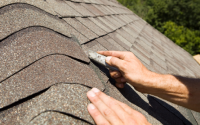Metal roofing has become an increasingly popular option for both flat and pitched roofs. It’s extremely durable, energy-efficient, and fire-retardant. A metal roof can be made up of corrugated panels or standing-seam. It may also be configured to resemble other types of roofing, such as shingles, tiles or wood shakes. While metal roofing is generally very tough, it may develop leaks especially at the seams where the pieces of metal join together. Corrosion and rust as well as improper roof design may also slowly cause damage to a metal roof, resulting in leaks.
If the metal roofing on your house is damaged and/or has developed leaks, you need to undertake immediate restoration. Failure to do so could see your insulation, walls, flooring, woodwork, as well as doors and windows, become damaged too.
Here is a simple, step-by-step roof restoration guide to get you started.
1. Roof analysis.
The first step in metal roof restoration is figuring out the extent of the damage and the kind of repair work needed. The fixing required will depend on the type and slope of your roof, as well as the size of the damage. So get on your roof (with safety equipment), locate, and evaluate the specific problems you need to fix. This can be structural damage, corrosion and rust, and/or leaks.
When inspecting the roof, take precautions not to step on the weak parts of the roof such as seams. You can use a large board to spread your weight while walking on the roof. Leaks can be problematic to locate as water doesn’t always travel straight down. Sometimes, water can seep down the walls, follow the truss system, or just pool up within the moisture barrier until it gets an outlet. Don’t be surprised if the leak in your bedroom originated from a loose or separated seam over your bathroom. To identify possible sources of leaks, check and pay close attention to areas such as:
- the J-rail
- worn-looking or rusted areas
- rubble buttons
- seams and sealant
- flashing around pipes, vents and skylights
Also, make sure you know about all past repair works done on your roof.
2. Preparation.
The actual metal roof restoration process starts with proper preparation of the affected part. This typically involves thorough cleaning, including removal of all dirt and debris prior to all work commencing. Once you have a clean, smooth surface, you can start the repair work. This step is very important, and it can have a bearing on the success of the entire project. So don’t skip it.
3. Repair
Your metal roof repairs will depend on:
- the nature of the damage
- roof type
- metal roofing material
- location of the problem
For small holes and rust spots, you can simply use a quality metal roofs sealant. Metal roofs sealants are very easy to use, and they provide a permanent solution to any leaks caused by small holes or rust spots, no matter the type of metal material used. All you need to do is to prepare the affected area, and apply the sealant according to the instructions provided by the manufacturer.
If the leaks are being caused by parted seams or small, narrow cracks, you can fill the spaces using a metal restoration system or good quality coating. Remove dirt on the affected area, and apply an aluminum base roof coating or any other restoration system. Ensure you apply the coating on both sides of the seam. Scrap off any loose or flaking coating using a putty knife.
For larger holes and badly corroded surfaces, you may need to patch the area using a piece of galvanized metal. Start by removing dirt and debris from the area to be patched. Scrape off any loose or flaking roof coating with a putty knife. Next, apply 2-inch wide strip of butyl tape around the affected area. The tape should be placed in such a way that it runs along the perimeter of your patch when you place it on top. Then, pre-drill holes through the patch, butyl tape, and the existing roof. Ensure the galvanized patch is flush with the metal roof surface before placing the screws to patch the area tight.
For extensive damage, you may have to cover the entire width of your roof as it’s easier and more effective than installing multiple metal patches. If the required repairs are beyond your scope, don’t shy from calling in a professional. Attempting such repairs can cause further problems later, as you don’t have the necessary knowledge and tools. Remember the repairs should only be undertaken in good weather. Lastly, a permit from the local authority may be required for re-roofing and other major metal roof restoration projects. But it may not be necessary for smaller repairs. Contact the city council or your local zoning authority to determine the exact stipulations prior to starting any work. If you intend to hire a metal roofing contractor for the repairs, you don’t have to worry about permits as they’ll get the necessary permits for you.

